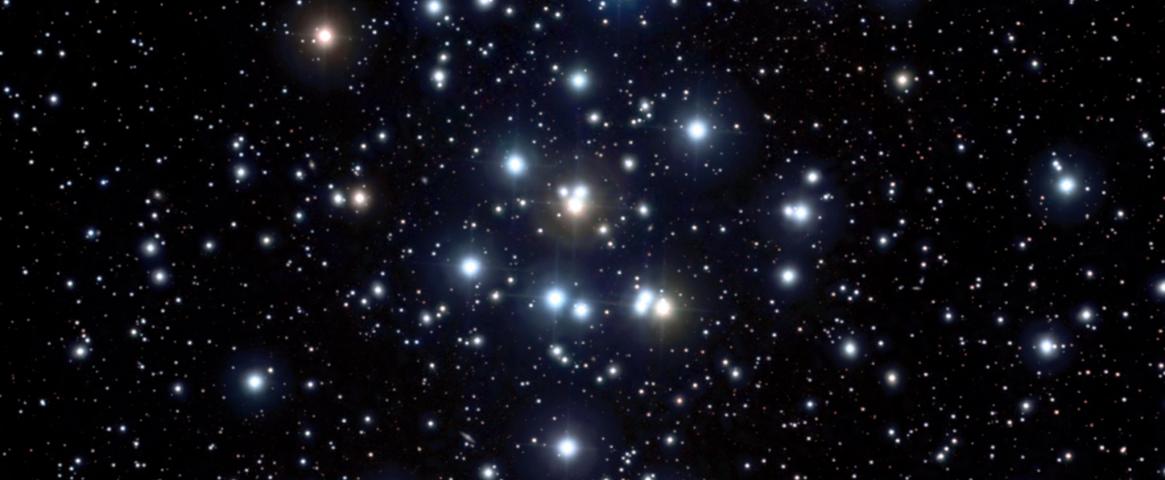This student story was published as part of the 2023 NASW Perlman Virtual Mentoring Program organized by the NASW Education Committee, providing science journalism practice and experience for undergraduate and graduate students.
Story by Elizabeth Watson
Mentored and edited by Kendra Redmond
A team of astronomers recently discovered magnetic anomalies in stars belonging to Praesepe, an open cluster of approximately 1,000 stars in the constellation Cancer. Some of Praesepe’s stars exhibit unusually powerful magnetic fields, as evidenced by the team’s research. The mechanism driving these anomalies could change what we know about stellar evolution.
“At first, it was just a set of little glitches that I wasn’t sure was robust, and then I started adding more clusters to the picture and thinking about where they lined up,” Lyra Cao, first author and VIDA postdoctoral fellow at Vanderbilt University, said. That’s when she realized an unexpected phenomenon might be behind her observations.
Resulting from activity within a star, stellar magnetic fields have the potential to provide insights into a star’s internal structure. Magnetic field strength is difficult to measure directly, but the team overcame this challenge through a method developed by Cao in 2022 alongside co-author Marc Pinsonneault, University Distinguished Scholar and professor of astronomy at Ohio State University. This method evaluates a star’s magnetism through its starspots — temporary spots on a star’s surface that form and dissipate due to magnetic activity.
The team applied this technique to datasets from multiple open clusters, and upon analyzing Praesepe, found especially powerful magnetic fields in some of its stars. Thus, Praesepe became the focus of the team’s work.
When low-mass stars like Praesepe’s first form, they rotate at the same angular momentum as the stellar clouds they originate from. As they rotate, these stars emit magnetically-driven winds that cause them to gradually lose momentum and spin down.
The team realized that Praesepe’s unusually magnetic stars had been flagged for rotational anomalies in previous years. Many of these stars seem to have stalled in spin down, indicating a possible deviation from usual models.
Models for stars like our sun posit magnetic fields are generated by the difference in rotational rates between a star’s equator and its poles, with stars participating in spin down as single units, but because of the anomalous magnetic behavior seen in Praesepe, the team believes these stars are driven by a different mechanism altogether: core-envelope decoupling.
In core-envelope decoupling, a star’s outer envelope and core spin down at independent rates. The internal shears that would result from such a model seem to explain the starspot and magnetic anomalies seen in the cluster but “detailed simulations and future work will be needed to understand the nature and morphology of these proposed radial shear dynamos, and if they are indeed perturbing the late-time evolution of low mass stars,” Cao said.
“This is very interesting work, conducted carefully,” according to Gibor Basri, Professor Emeritus in the University of California, Berkeley’s Department of Astronomy. He noted the complexity of the problem at hand and acknowledged that other explanations may be at play, but described the work as “a potentially significant advancement of our knowledge.” Basri was not associated with the study.
Confirmation of this model in Praesepe could pave the way for a new understanding of stellar evolution.
“I remember Lyra showing me the plot of the Praesepe stars for the first time, and that feeling of ‘wow, look at that!’ the first time she compared it to a model and everything crystallized into a clear picture,” Jennifer van Saders, co-author and associate astronomer at the Institute for Astronomy at the University of Hawaii at Manoa, said. “Not every project has a moment when the picture just snaps into place and you realize what you’re looking at, but this one did, and it’s always really special when it happens that way.” Cao enjoyed working with her co-authors throughout the study. “I love just how kind and intellectually curious my collaborators are, and just how much intellectual freedom we have to explore such fascinating ideas,” Cao said. Van Saders agreed. “There’s nothing quite like sitting down with a few other curious and enthusiastic colleagues to try and figure out a puzzle together,” she said. “It was immensely fun to bounce ideas around with Marc and Lyra, and then work with them to turn this idea into a paper. It’s a pretty rare and special feeling to think that you and a few people you’ve been working with closely have just found something that no one knew before — and now get to share it with the rest of the community.” The study was published in Astrophysical Journal Letters on July 19th.
Main Image Caption: The open cluster Praesepe, commonly known as the Beehive cluster, contains approximately 1,000 stars, and was the focus of the study. Credit: Giuseppe Donatiello. (Creative Commons CC0 1.0 Universal Public Domain Dedication)
Elizabeth Watson is a junior at Yale University double majoring in Ecology and Evolutionary Biology (E&EB) and Humanities. She was previously a Science and Technology Editor for the Yale Daily News and currently serves as the Social Media Team Head at Yale Scientific Magazine. Follow her on LinkedIn, or email her at elizabeth.watson@yale.edu.
The NASW Perlman Virtual Mentoring program is named for longtime science writer and past NASW President David Perlman. Dave, who died in 2020 at the age of 101 only three years after his retirement from the San Francisco Chronicle, was a mentor to countless members of the science writing community and always made time for kind and supportive words, especially for early career writers. Contact NASW Education Committee Co-Chairs Czerne Reid and Ashley Yeager and Perlman Program Coordinator Courtney Gorman at mentor@nasw.org. Thank you to the many NASW member volunteers who spearhead our #SciWriStudent programming year after year.
Founded in 1934 with a mission to fight for the free flow of science news, NASW is an organization of ~ 2,600 professional journalists, authors, editors, producers, public information officers, students and people who write and produce material intended to inform the public about science, health, engineering, and technology. To learn more, visit www.nasw.org



